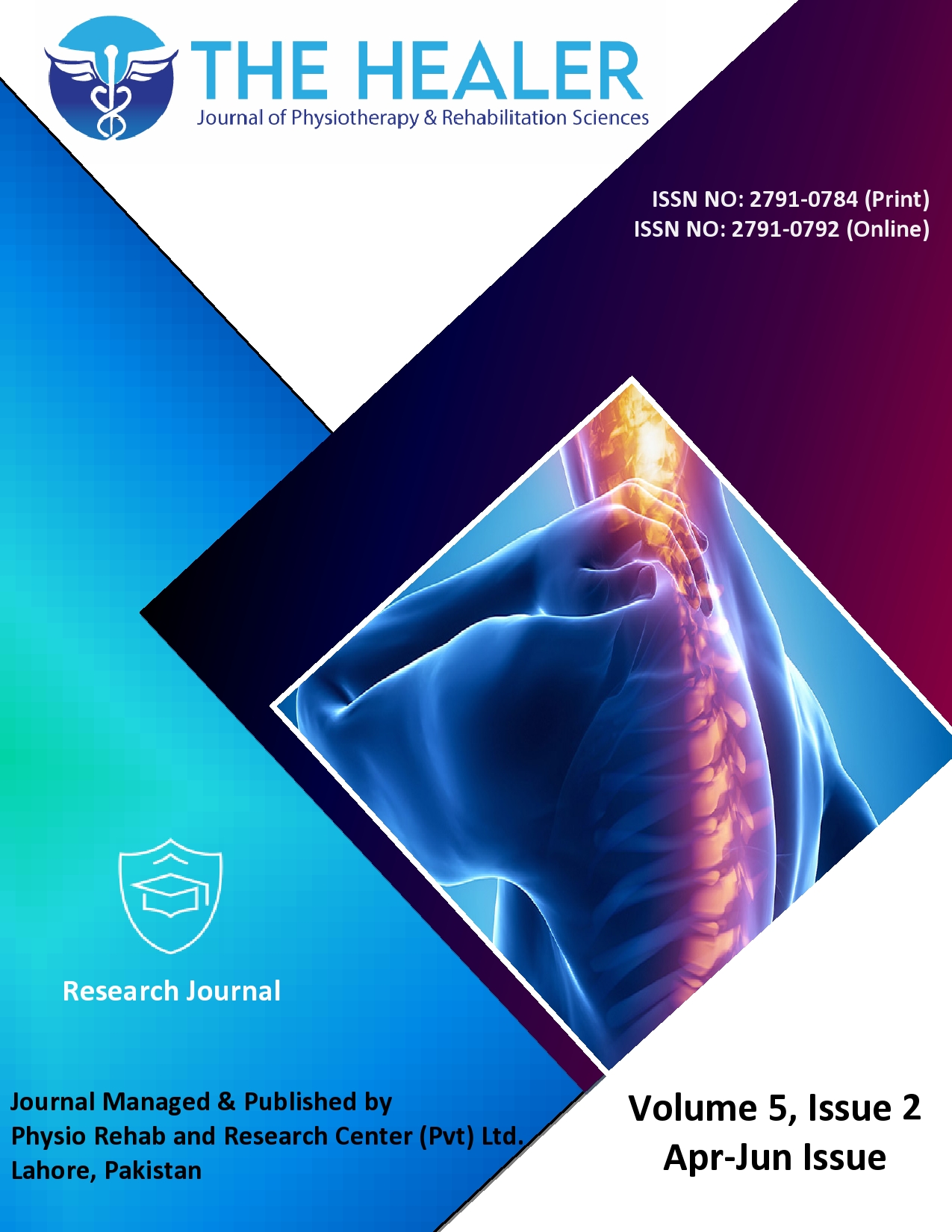Effects of Dual-Task Balance and Gait Training on Fear of Falling and Functional Independence in Older Adults: A Randomised Controlled Trial
DOI:
https://doi.org/10.55735/gpw2fj74Keywords:
Balance , Dual-task training , Fall prevention , Fear of falling , Functional independence , Older adultsAbstract
Background: Fear of falling and gait difficulties are major contributors to physical and psychological decline in older adults. These issues restrict mobility, reduce confidence, and increase the risk of dependence and social withdrawal. Objective: To investigate the effects of dual-task balance and gait training on fear of falling and functional independence in older adults. Methodology: This controlled trial was conducted from April to September 2024 at Hayatabad Medical Complex, Peshawar. Participants were community-dwelling older adults ≥60 years who could walk independently and had experienced at least one fall or reported fear of falling in the past year. Exclusion criteria were advanced osteoarthritis, recent fractures, stroke, neurological disorders, uncorrected vestibular/visual impairments, cardiovascular disease, or recent surgery. Randomisation through a lottery method assigned participants to either the dual-task or conventional balance training group (36 each). A mini-mental state examination score ≥24 ensured adequate cognition. Primary outcomes were fear of falling, measured with the Falls Efficacy Scale-International, and functional independence, assessed by the Barthel Index. Secondary outcomes included gait parameters, Timed Up and Go, and the 10-meter walk test. Data were expressed as mean±SD or frequencies/percentages. Normality was tested with the Shapiro-Wilk test; between-group comparisons used two-way repeated measures ANOVA with Bonferroni correction, and within-group changes were tested using paired t-tests or Wilcoxon signed-rank tests. Results: The intervention group showed significantly greater improvements in FES-I (p<0.00), BI (p=0.00), gait velocity (p<0.00), stride length (p=0.01), and dual-task TUG (p<0.00). Fear of falling declined by 28% in the dual-task group compared to 12% in controls, while functional independence improved by 20% versus 9%. Conclusion: Dual-task training is more effective than single-task balance training for reducing fear of falling and improving independence.
Downloads
References
1. Spanò B, Lombardi M G, De Tollis M, et al. Effect of Dual-Task Motor-Cognitive Training in Preventing Falls in Vulnerable Elderly Cerebrovascular Patients: A Pilot Study. Brain Sciences. 2022; 12(2): 168.
https://doi.org/10.3390/brainsci12020168
2. Nascimento CMC, Pereira JR, de Andrade LP, et al. Dual-task training improves cognition and mobility in community-dwelling older adults: a randomized controlled trial. Frontiers in Ageing Neuroscience. 2021; 13:649159.
https://doi.org/10.3389/fnagi.2021.589299
3. Sherrington C, Michaleff Z A, Fairhall N, et al. Exercise to prevent falls in older adults: an updated systematic review and meta-analysis. British Journal of Sports Medicine. 2017; 51(24): 1750-1758.
https://doi.org/10.1136/bjsports-2016-096547
4. Smith-Ray RL, Hughes SL, Prohaska TR, Little DM, et al. Impact of Cognitive Training on Balance and Gait in Older Adults. The journals of gerontology. 2015; 70(3): 357-366.
https://doi.org/10.1093/geronb/gbt097
5. Hiyamizu M, Morioka S, Shomoto K, et al. Effects of dual task balance training on dual task performance in elderly people: a randomized controlled trial. Clinical Rehabilitation, 2012; 26(1): 58-67.
https://doi.org/10.1177/0269215510394222
6. Plummer P, Zukowski LA, Giuliani C, Hall AM, Zurakowski D. Effects of physical exercise interventions on cognition and dual-task performance in older adults: a systematic review and meta-analysis. Gerontology. 2015; 62(1): 94-117.
https://doi.org/10.1159/000371577
7. Wollesen B, Voelcker-Rehage C, Regenbrecht T, & Mattes K. Influence of a visual-verbal Stroop test on standing and walking performance of older adults. Neuroscience. 2016; 318:166–177.
https://doi.org/10.1016/j.neuroscience.2016.01.031
8. Mirelman A, Rochester L, Maidan I, et al. Addition of a non-immersive virtual reality component to treadmill training to reduce fall risk in older adults (V-TIME): a randomized controlled trial. Lancet. 2016; 388(10550): 1170-82.
https://doi.org/10.1016/S0140-6736(16)31325-3
9. Agmon M, Belza B, Nguyen HQ, Logsdon RG, Kelly VE. A systematic review of interventions conducted in clinical or community settings to improve dual-task postural control in older adults. Clinical Interventions in Aging. 2014; 9:477-92.
https://doi.org/10.2147/CIA.S54978
10. Koo D K, Jang T S, & Kwon J W. Effects of Dual-Task Training on Gait Parameters in Elderly Patients with Mild Dementia. Healthcare (Basel, Switzerland). 2021; 9(11): 1444.
https://doi.org/10.3390/healthcare9111444
11. Montero-Odasso M, Bergman H, Phillips N A et al. Dual-tasking and gait in people with Mild Cognitive Impairment. The effect of working memory. BMC Geriatrics. 2009; 9: 41
https://doi.org/10.1186/1471-2318-9-41
12. Park E C, Kim S G, & Lee C W. The effects of virtual reality game exercise on balance and gait of the elderly. Journal of Physical Therapy Science. 2005: 27(4):1157-1159.
https://doi.org/10.1589/jpts.27.1157
13. Li KZH, Bherer L, Mirelman A, Maidan I, Hausdorff JM. Cognitive involvement in balance, gait and dual-tasking in aging: A focused review from a neuroscience of aging perspective. Front Neurol. 2018; 9: 913.
https://doi.org/10.3389/fneur.2018.00913
14. Plummer-D’Amato P, Altmann LJ, Reilly K. Dual-task effects of spontaneous speech and executive function on gait in aging: exaggerated effects in slow walkers. Gait Posture. 2011; 33(2): 233-7.
https://doi.org/10.1016/j.gaitpost.2010.11.011
15. Trombini-Souza F, de Moura VTG, da Silva LWN, et al. Effects of two different dual-task training protocols on gait, balance, and cognitive function in community-dwelling older adults: a 24-week randomized controlled trial. PeerJ. 2023; 11: e15030
https://doi.org/10.7717/peerj.15030
16. Spano B, Lombardi M G, Tollis M, et al. Effect of Dual-Task Motor-Cognitive Training in Preventing Falls in Vulnerable Elderly Cerebrovascular Patients: A Pilot Study. Brain Sciences. 2022; 12(2): 168
https://doi.org/10.3390/brainsci12020168
17. Jardim N Y V, Bento-Torres N V O, Costa V O, et al. Dual-Task Exercise to Improve Cognition and Functional Capacity of Healthy Older Adults. Frontiers in Aging Neuroscience. 2021; 13:589299.
https://doi.org/10.3389/fnagi.2021.589299
18. Lee Y, Jung J, Kim H, Lee S. Comparison of the Influence of Dual-Task Activities on Prefrontal Activation and Gait Variables in Older Adults with Mild Cognitive Impairment during Straight and Curved Walking. Medicina. 2024; 60(2): 235.
https://doi.org/10.3390/medicina60020235
19. Jehu D A, Langston R, Patel C, et al. The Effects of Six Months of Exercise on Single- and Dual-Task Posture, Gait, and Functional Mobility Relative to Usual Care Alone Among People Living with Dementia: The ENABLED Pilot Randomized Controlled Trial. Applied Science. 2025; 15(12):6624.
https://doi.org/10.3390/app15126624
20. Wollesen B, Schulz S, Seydell L, et al. Does dual-task training improve the walking performance of older adults with concerns of falling? BMC Geriatrics. 2017; 17(1): 213.
https://doi.org/10.1186/s12877-017-0610-5
21. Mou C, Jiang Y. Effect of dual task-based training on motor and cognitive function in stroke patients: a systematic review and meta-analysis of randomized controlled trials. BMC Neurology. 2025: 25(1): 290.
https://doi.org/10.1186/s12883-025-04305-2
22. Uysal, İ, Özden F, Yalçın M, et al. The effect of dual-task training in older adults with total hip arthroplasty: a randomized controlled trial. BMC Musculoskeletal Disorders. 2025; 26(1): 29.
https://doi.org/10.1186/s12891-025-08279-7
23. Wei X, Huang C, Ding X, et al. Effect of virtual reality training on dual-task performance in older adults: a systematic review and meta-analysis. Journal of Neuroengineering and Rehabilitation. 2025; 22(1): 141.
https://doi.org/10.1186/s12984-025-01675-z
24. Varela-Vásquez LA, Minobes-Molina E, Jerez-Roig J. Dual-task exercises in older adults: A structured review of current literature. J Frailty Sarcopenia Falls. 2020; 5(3): 31-37.
https://doi.org/10.22540/JFSF-05-031
25. Silsupadol P, Shumway-Cook A, Lugade V, et al. Effects of single-task versus dual-task training on balance performance in older adults: a double-blind, randomized controlled trial. Archives of Physical Medicine And Rehabilitation. 2009; 90(3): 381-387.
https://doi.org/10.1016/j.apmr.2008.09.559
26. Oliveira JS, Sherrington C, Paul SS, et al. A combined physical activity and fall prevention intervention improved mobility-related goal attainment but not physical activity in older adults: a randomised trial. Journal of Physiotherapy. 2018; 65(1): 16-22.
https://doi.org/10.1016/j.jphys.2018.11.005
27. Mundada P H, Dadgal R M. Comparison of Dual Task Training Versus Aerobic Training in Improving Cognition in Healthy Elderly Population. Cureus. 2022; 14(9): e29027.
https://doi.org/10.7759/cureus.29027
28. Teraz K, Šlosar L, Paravlić A H, et al. Impact of Motor-Cognitive Interventions on Selected Gait and Balance Outcomes in Older Adults: A Systematic Review and Meta-Analysis of Randomized Controlled Trials. Frontiers in Psychology. 2022; 13: 837710.
https://doi.org/10.3389/fpsyg.2022.837710
29. Tao X, Sun R, Han C, Gong W. Cognitive-motor dual task: An effective rehabilitation method in aging-related cognitive impairment. Frontiers in Aging Neuroscience. 2022; 14: 1051056
https://doi.org/10.3389/fnagi.2022.1051056
30. Nayak A, Alhasani R, Kanitkar A, et al. Dual-Task Training Program for Older Adults: Blending Gait, Visuomotor and Cognitive Training. Frontiers in Network Physiology. 2021; 1:736232.

Downloads
Published
License
Copyright (c) 2025 The Healer Journal of Physiotherapy and Rehabilitation Sciences

This work is licensed under a Creative Commons Attribution 4.0 International License.













